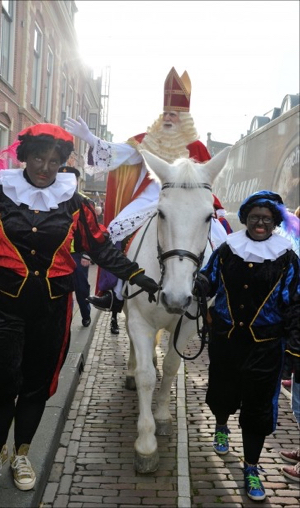
St. Nicholas arrives on horseback, flanked by Black Peter. Photo courtesy of PublicDomainPictures.net
THURSDAY, DECEMBER 6: The white-bearded man in the red suit may travel by reindeer in the West, but today, Sinterklaas, or San Nicola, arrives across Europe on horseback—for St. Nicholas Day. For European children, St. Nicholas Day brings hope of sweets, small toys and surprises, as the fourth-century saint makes his rounds with Zwarte Piet (Black Peter). For Christian families, the excitement and gifts of St. Nicholas Day can better prepare children for focus on the Nativity on Christmas Day.
Advent season: For more than a billion Western Christians, Advent begins before St. Nicholas day. (The first Advent Sunday is December 2 in 2018.)
Nativity Fast: For Eastern Orthodox Christians, the 40-day fasting period known as Nativity Fast lasts through December 24.
NICHOLAS: A BISHOP BECOMES A LEGEND
The historical St. Nicholas was born in the 3rd century in modern-day Turkey. When orphaned at a young age, Nicholas followed the words of Jesus and sold his inheritance, giving the profits to the poor. (Learn more from St. Nicholas Center.) The generous young man devoted his life to God and was soon made bishop of Myra, where his reputation for compassion continued. Despite imprisonment and persecution during the reign of Roman Emperor Diocletian, Bishop Nicholas unwaveringly continued his servitude toward others .
Stories of his works and deeds spread throughout the land, and some of those stories are still told on St. Nicholas Day today. In 343 CE, St. Nicholas died in Myra. A relic, known as manna, formed on his grave, and the substance was believed to have healing properties.
NIKOLAOS THE WONDERWORKER & EUROPEAN TRADITIONS
In the many countries that observe St. Nicholas Day—the Netherlands, France, Germany, Italy, Austria, Bulgaria and more—the day is met with special baked goods, processions and reenactments of wonderful stories from the life of St. Nicholas. In Germany and Poland, boys dress as bishops and beg for alms for the poor; in France, the spicy smell of gingerbread cookies and mannala (a brioche shaped like the bishop) fills kitchens and bakeries. St. Nicholas is the most popular family patron saint in Serbia. Throughout Europe, children leave their shoes out on the evening of December 5, to be filled with either treats or coal by the passing St. Nicholas and his sidekick companion, Zwarte Piet.
RESOURCES: ST. NICHOLAS CENTER OFFERS ACTIVITIES, RECIPES & MORE
This year, the nonprofit St. Nicholas Center has expanded its free printables, stories, handmade gifts and more with 49 new features: a video to introduce St. Nicholas, intended for St. Nicholas events and a handout on The Real Santa (with an Eastern image, too) are just a few of the features. Visitors to the site can find printable candy bar wrappers, paper bag puppets, cookies and even a religious devotional for churches—all with the intention of spreading the story of the life of the famed bishop of Myra.
Learn about the life of St. Nicholas, here. For children, check out this page.
Bake Speculaas cookies, gluten-free Speculoos and Ukrainian Christmas Honey Cookies, with recipes here.
Get creative with craft ideas and directions, here.
Access St. Nicholas Day blessings and other faith-based resources, here.